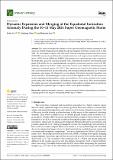| dc.contributor.author | Aa, Ercha | |
| dc.contributor.author | Chen, Yanhong | |
| dc.contributor.author | Luo, Bingxian | |
| dc.date.accessioned | 2024-11-27T17:27:03Z | |
| dc.date.available | 2024-11-27T17:27:03Z | |
| dc.date.issued | 2024-11-18 | |
| dc.identifier.uri | https://hdl.handle.net/1721.1/157691 | |
| dc.description.abstract | first_pagesettingsOrder Article Reprints
Open AccessTechnical Note
Dynamic Expansion and Merging of the Equatorial Ionization Anomaly During the 10–11 May 2024 Super Geomagnetic Storm
by Ercha Aa 1,2,*ORCID,Yanhong Chen 2ORCID andBingxian Luo 2ORCID
1
Haystack Observatory, Massachusetts Institute of Technology, Westford, MA 01886, USA
2
National Space Science Center, Chinese Academy of Sciences, Beijing 100190, China
*
Author to whom correspondence should be addressed.
Remote Sens. 2024, 16(22), 4290; https://doi.org/10.3390/rs16224290
Submission received: 24 October 2024 / Revised: 14 November 2024 / Accepted: 15 November 2024 / Published: 18 November 2024
(This article belongs to the Special Issue Ionosphere Monitoring with Remote Sensing (3rd Edition))
Downloadkeyboard_arrow_down Browse Figures Versions Notes
Abstract
This study investigates the responses of the equatorial and low-latitude ionosphere in the American–Atlantic longitude sector during the super geomagnetic storm that occurred on 10–11 May 2024. The investigation utilizes multi-instrument datasets, including ground-based observations (GNSS TEC, ionosonde, and Fabry–Perot interferometer) as well as space-borne satellite measurements (GOLD, Swarm, DMSP, and TIMED). Our findings reveal significant day-to-day variations in the storm-time equatorial ionization anomaly (EIA), summarized as follows: (1) During the main phase of the storm, the low- and mid-latitude ionosphere experienced a positive storm, with TEC drastically enhanced by 50–100% within a few hours. The EIA crests exhibited a substantial poleward expansion, reaching as high as ±35° MLAT. This expansion was caused by the enhanced fountain effect driven by penetration electric fields, along with increased ambipolar diffusion due to transient meridional wind surges. (2) During the recovery phase of the storm, the global ionosphere was characterized by a substantial negative storm with a 50–80% depletion in TEC. The EIA crests were notably suppressed and merged into a single equatorial band, which can be attributed to the composition change effect and the influence of disturbance dynamo electric fields. These results illustrate the complex processes of magnetosphere–ionosphere–thermosphere coupling during a superstorm, highlighting the significant impacts of space weather on the global ionosphere. | en_US |
| dc.publisher | Multidisciplinary Digital Publishing Institute | en_US |
| dc.relation.isversionof | http://dx.doi.org/10.3390/rs16224290 | en_US |
| dc.rights | Creative Commons Attribution | en_US |
| dc.rights.uri | https://creativecommons.org/licenses/by/4.0/ | en_US |
| dc.source | Multidisciplinary Digital Publishing Institute | en_US |
| dc.title | Dynamic Expansion and Merging of the Equatorial Ionization Anomaly During the 10–11 May 2024 Super Geomagnetic Storm | en_US |
| dc.type | Article | en_US |
| dc.identifier.citation | Aa, E.; Chen, Y.; Luo, B. Dynamic Expansion and Merging of the Equatorial Ionization Anomaly During the 10–11 May 2024 Super Geomagnetic Storm. Remote Sens. 2024, 16, 4290. | en_US |
| dc.contributor.department | Haystack Observatory | en_US |
| dc.relation.journal | Remote Sensing | en_US |
| dc.identifier.mitlicense | PUBLISHER_CC | |
| dc.eprint.version | Final published version | en_US |
| dc.type.uri | http://purl.org/eprint/type/JournalArticle | en_US |
| eprint.status | http://purl.org/eprint/status/PeerReviewed | en_US |
| dc.date.updated | 2024-11-26T17:43:06Z | |
| dspace.date.submission | 2024-11-26T17:43:06Z | |
| mit.journal.volume | 16 | en_US |
| mit.journal.issue | 22 | en_US |
| mit.license | PUBLISHER_CC | |
| mit.metadata.status | Authority Work and Publication Information Needed | en_US |
